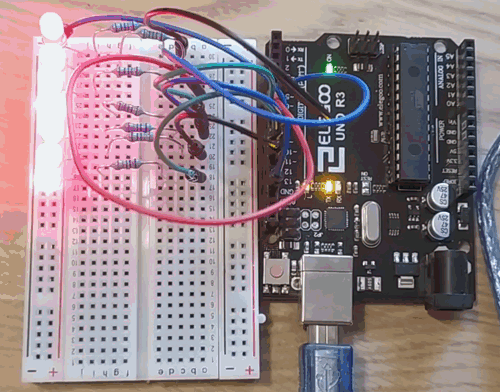Quantum Computing on Arduino

In a world where tech giants are pouring billions into quantum computing, spending fortunes on superconducting circuits and cryogenic cooling systems, I decided to take a slightly different approach. Armed with nothing more than an Arduino Uno (actually a much cheaper Elegoo Uno), a handful of LEDs, and an unquenchable thirst for quantum supremacy, I’ve created a quantum emulator that will make those fancy-pants quantum computers shake in their expensively cooled boots.
I present to you: the Arduino Quantum Computer. With a whopping 7 qubits, this powerhouse of quantum computation fits in the palm of your hand and runs at room temperature. Take that, dilution refrigerators!

Now, you might be thinking, “But wait, doesn’t Google’s Sycamore processor have 53 qubits? And isn’t IBM’s latest quantum computer boasting 433 qubits?” Well, sure, if you want to get all technical about it. But let me ask you this: can their quantum computers blink LEDs? I didn’t think so.
Our plucky Arduino quantum emulator supports all your favorite quantum gates: Hadamard, CNOT, X, Y, S, T and Z. It can even prepare a GHZ state faster than you can say “quantum entanglement” (assuming you say it really, really slowly).
H(0);
for(int i = 0; i < NUM_QUBITS - 1; i++) {
CX(i,i+1);
}

The best part? While those other quantum computers require teams of PhD physicists to operate, our Arduino quantum emulator can be programmed by anyone with a basic understanding of C++ and a complete disregard for actual quantum mechanics.
But wait, there’s more! Unlike those other quantum computers that need to be isolated from all external interference, our Arduino quantum computer thrives on noise. In fact, it uses the analog noise from an unconnected pin to seed its random number generator. It’s not a bug, it’s a feature!
randomSeed(analogRead(0));
Now, I know what you’re thinking: “This is revolutionary! How much does it cost?” Well, prepare to be amazed. While other quantum computers cost millions, you can build this quantum powerhouse for the low, low price of about $25 (or $10 if you buy a cheaper Elegoo). That’s right, for the cost of a nice dinner, you too can join the quantum computing revolution.
In conclusion, while other researchers waste their time with trivial problems like factoring large numbers or simulating complex quantum systems, we’ll be over here, blinking LEDs in superposition. The future of quantum computing is here, and it runs on 5 volts.
Code is open-source and available on the following github repository under Apache License.
Check out also my Commodore64 quantum emulator.
Disclaimer: This quantum emulator may not actually solve any real-world problems faster than a classical computer. But hey, neither do most other quantum computers right now, so we’re in good company!
During my Quantum Computing journey, I often needed to simulate some quantum circuits; sometimes they are small, but some other times they are bigger enough ...
Despite it is sold as a non-cartographic handled GPS device, with limited storage capacity of 10 MB and the inability to expand it, the eTrex 10 GPS, like al...
Since the latest v0.1.18 version, the Qlasskit library offers two useful tool for circuit analysis and optimization.
In the last release of Qlasskit, I introduced a new feature able to export a qlassf function to a binary quadratic model (as bqm, qubo or ising model). This...
In early 2023, I embarked on a journey to explore the field of probabilistic computing. This endeavor culminated in the construction of a hardware prototype,...
Today, I’m going to show you how to use Qlasskit to create a quantum circuit able to search for Sudoku puzzle solutions.
In a recent article I wrote, “Quantum Computing on a Commodore 64 in 200 Lines of BASIC”, published both on Medium and Hackaday.com, shows a two-qubit quantu...
Traditionally, creating quantum circuits requires specialized knowledge in quantum programming. This requirement holds true when encoding a classical algorit...
In an age where companies are selling two-qubit quantum computers for a sum of money that would make your wallet recoil in horror, here we are, stepping off ...
This June I emerged as one of the top participants with 9 bounties collected (alongside another exceptional contributor) in the #UnitaryHack Hackathon, hoste...
A few days ago I came across a yt video discussing the ESA Copernicus program, a European initiative for monitoring earth via a satellite constellation. This...
Qiskit is a python SDK developed by IBM and allows everyone to create quantum circuits, simulate them locally and also run the quantum circuit on a real quan...
As someone noticed from the previous post, last weeks I started to write a new programming language for Tezos smart contracts. This project was initially int...
While writing a new programming language, it is often useful to write some real use-cases to test the syntax, the language expressiveness and the code cleann...
Documentation is like sex: when it is good, it is very, very good; and when it is bad, it is better than nothing
This is my new blog, based on jekyll. I’ll soon import old posts from my old blog.
Contractvm is a general-purpose decentralized framework based on blockchain. The framework allows to implement arbitrary decentralized applications in an eas...
Most of bitcoin dice software use a system to prove the fair play of the server for each bet. Most of them implement this mechanism using two seed (server se...
In the aim to merge two of my server on digitalocean, today I tried to write a mod_rewrite rule to redirect a secondary domain to a subfolder. After one hour...
MineML is a multithread CPU based bitcoin miner written in F#. At the moment it’s a slow implementation, but the class structure offers the possibility to im...